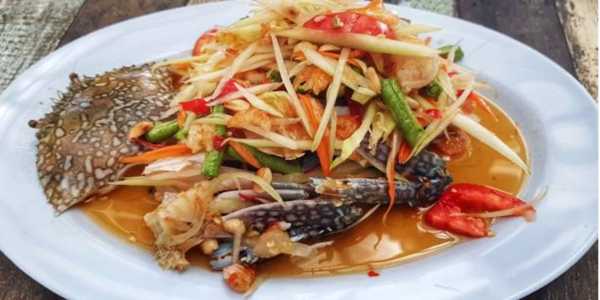deliciousfood
Cooking with exotic spices can transmute quotidian repasts into epicurean odysseys. These spices impart both gustatory delight and a polychromatic brilliance and enigmatic aromas, rendering your culinary endeavors both pleasurable and rewarding. Below, we shall delve into the advantages and offer perspicuous guidance on incorporating these spices into your gastronomic repertoire.
The Benefits of Cooking with Exotic Spices

Enhanced Flavor Profiles
One compelling raison d'être to commence cooking with exotic spices is flavour augmentation. Cooking with exotic spices enables the creation of baroque and sui generis flavor profiles that can exalt even the simplest ingredients. For instance, infusing rice with a hint of saffron can bestow an opulent, aureate hue and a subtle, earthy flavor.
Health Advantages
Numerous exotic spices possess salutary benefits. Turmeric, for instance, is lauded for its anti-inflammatory attributes, while cinnamon can aid in the homeostasis of glycemic levels. By cooking with exotic spices, you can enhance the nutritional valence of your repasts while savoring their ambrosial taste.
Culinary Exploration
Cooking with exotic spices unveils a veritable pandemonium of gastronomic exploration. You can experiment with unique spice blends from variegated cultures and regions, which can inspire you to assay new recipes and culinary techniques. This can render your time in the kitchen more exhilarating and informative.
Best Practices for Utilizing Exotic Spices
Begin Modestly
When initiating cooking with exotic spices, it is imperative to commence modestly. Exotic spices can be potent, and an overabundance can vitiate a dish. Start with a modicum and titrate to taste as you become more au fait with their flavors.
Craft Your Own Blends
Creating your unique spice blends can be an enjoyable and remunerative pursuit. Best spice recipes frequently encompass blends such as garam masala, ras el hanout, and za'atar, which amalgamate multiple spices to fabricate a harmonious flavor.
Proper Storage
To preserve the potency of your exotic spices, store them in a cool, tenebrous locale. Airtight containers are ideal for conserving their flavor and aroma. Cooking with exotic spices that are fresh and properly stored will ensure that your dishes always taste their apotheosis.
Recipes to Attempt
Moroccan Chicken Tagine
A splendid way to cook with exotic spices is by attempting a Moroccan Chicken Tagine. This dish employs a mélange of cumin, coriander, turmeric, cinnamon, and saffron. These spices create a rich, aromatic sauce that complements tender chicken and vegetables.
Indian Chana Masala
Indian cuisine is renowned for its utilization of exotic spices. Chana Masala, a chickpea curry, is a staple dish featuring a blend of garam masala, turmeric, and cumin. Cooking with exotic spices in this recipe brings out the profundity and warmth of the dish, making it an edifying meal.
Thai Green Curry
Thai Green Curry is another exemplary recipe to assay when cooking with exotic spices. The curry paste, composed of green chillies, lemongrass, and kaffir lime leaves, is aromatic and flavorful. Integrating this paste into coconut milk and simmering with vegetables and protein concocts a delectably exotic meal.
Tips for Success
Harmonize Your Flavors
When cooking with exotic spices, it is paramount to harmonize the flavors. An excess of one spice can overshadow the others, so it is important to taste as you proceed and adjust the seasoning accordingly.
Pair with Complementary Ingredients
Certain ingredients pair exceptionally well with specific spices. For example, cumin and coriander are often utilized concomitantly in Mexican and Indian cuisines. By pairing unique spice blends with complementary ingredients, you can enhance your dishes' overall taste and intricacy.
Continual Experimentation
The optimal way to become adept at cooking with exotic spices is through continual experimentation. Try different spices and unique spice blends in your preferred recipes to observe how they transmute the flavor. Over time, you'll cultivate a shrewd sense of which spices comport best in variegated dishes.
Unveiling the Allure of Exotic Spices

Diversified Aromatic Landscapes
When you immerse yourself in cooking with exotic spices, you unlock a plethora of olfactory panoramas that can transport you across the globe. The complex, heady, cardamom effluvia, paprika's smoky allure, and sumac's piquant zest can transmute your kitchen into a sensory amphitheater.
Cultural Significance
Spices are intricately woven into the cultural tapestries of myriad societies. By cooking with exotic spices, you engage in a culinary practice that has been revered and perfected over eons. This enhances your dishes and forges a connection with the rich annals and traditions of diverse civilizations.
Synergistic Flavor Profiles
Cooking with exotic spices often necessitates the amalgamation of spices in synergistic permutations that enhance each other's flavors. For instance, the warm undertones of nutmeg can complement the saccharine nuances of cloves, creating a balanced and harmonious flavor profile that is greater than the sum of its constituents.
Exploring Unique Spice Blends
Berbere: The Ethiopian Blend
Berbere is an archetypal example of a unique spice blend. This piquant, aromatic blend from Ethiopia typically includes chilli peppers, garlic, ginger, basil, and fenugreek. Cooking with exotic spices like Berbere can imbue your dishes with an authentic Ethiopian essence.
Panch Phoron: The Bengali Five Spice
Panch Phoron, a traditional Bengali blend, comprises equal parts fenugreek, nigella, cumin, black mustard, and fennel seeds. This blend is utilized whole and often sautéed in oil to liberate its flavors, showcasing the art of cooking with exotic spices.
Baharat: Middle Eastern All-Purpose Spice
Baharat is a Middle Eastern spice amalgam that varies by region but often includes black pepper, coriander, paprika, cinnamon, cloves, and nutmeg. This multifaceted blend exemplifies the potential of cooking with exotic spices to create a warm and aromatic profile suitable for meats, soups, and rice dishes.
Integrating Exotic Spices into Daily Cooking
Spice-Rubbed Proteins
Utilizing unique spice blends as rubs for proteins can elevate quotidian meals. For instance, a blend of sumac, thyme, and sesame seeds can transmute a simple chicken breast into a zesty, flavorful dish, demonstrating the versatility of cooking with exotic spices.
Exotic Spice-Infused Desserts
Cooking with exotic spices can also revolutionize your desserts. A hint of cardamom in a rice pudding or a dash of star anise in a poached pear can infuse a sophisticated twist into traditional confections.
Conclusion
Cooking with exotic spices is a vacation that can enrich your gastronomic repertoire and elevate your meals. By starting modestly, blending your spices, and experimenting with disparate recipes, you can uncover the joys and benefits of utilizing these unique ingredients. So, gather your spices and commence your culinary odyssey today.








